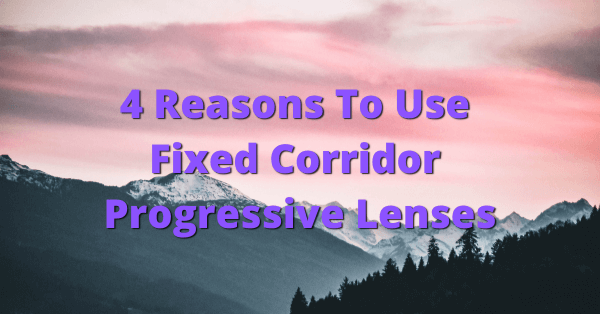4 Reasons To Use Fixed Corridor Progressive Lenses

In September of 2018 we took a look at the differences between fixed corridor vs. variable corridor digital progressives. While this is a good explanation of how to get the best out of each, fixed corridor progressive lenses can give you a new arsenal to keep your patients happy.
We are seeing more of our customers choosing fixed corridor for their patients progressive glasses and for good reason. This blog will give you best practices when fitting your patients with fixed corridor progressives. The first step is using a product that allows for fixed corridor length. Shamir, Seiko, and our house brands (Legacy and Heritage) give you this ability.
Not every patient is accustomed to new progressive lenses. Some still refer to them as no-line multifocal eyeglass lenses or line-free progressive lenses. Times have changed and modern progressive lenses give you and your patients more control than ever! Following these 4 easy guidelines will help ensure your patients have their best possible experience.
1) Fixed allows you to control the location of the reading area in relationship to the pupil. When setting the segment height on a FT-28, you do not care what the height is or what the B measurement is. Your only concern is the position of the top of the segment in relationship to the pupil. When you fix the corridor length with a progressive you are doing much the same.
Shamir guarantees at least 5 mm of reading area with all of their fixed designs when you choose a fixed length equal to or below the segment height. With this in mind, when you choose a fixed 15 you will have 10 mm of corridor before entering the reading zone. A fixed 13 mm will have 8 mm of corridor etc. This rule of thumb works with most fixed designs.
2) Utilizing a fixed corridor allows for consistency in design from frame to frame. You might have a patient purchase 2 frames that are very different in shape and size. Let’s say frame #1 has a shorter B with a seg height of 15 and frame #2 has a deep B with a seg height of 22.
If you chose a variable corridor design your patient will have a much different experience with the 2 pairs of glasses because the reading area would be much deeper in frame #2 than frame #1. By using a fixed 14 on both pairs you would give your patient a consistent reading location on both, which will be more comfortable for them.
An important guideline to follow here is that you always choose a corridor length that is shorter than the seg height. If you choose a fixed 18 with a seg height of 17, you will be cutting off part of the reading area.
3) Most patients are very specific on how they use their lenses. You might find a patient who's key needs are in distance and reading with very little need for intermediate. This is a perfect candidate for a shorter corridor regardless of segment height.
By fixing to a short corridor you are enabling your patient to transition from distance to near faster. This is an added benefit not only in comfort, but by getting them deeper into the reading area. This will allow them to experience a wider reading area.
4) We are now seeing the trend of larger frames taking hold throughout the US. Many of your patient are coming out of narrow B frames with short corridor progressives and moving into a deep B frame with a much higher segment height.
Your patients have spent years getting use to their reading zone being very close to their pupil and now they will have to get use to it being much lower. Why put them through this? Simply choose a shorter fixed corridor. This will keep them comfortable with the reading zone location.
In the correct setting, utilizing a proper fixed corridor will benefit your patients, resulting in increased satisfaction and an improved non-adapt ratio.
Just simply having a good conversation with your patients and listening to their needs will go a long way. By utilizing tricks and tools like fixed corridor you'll not only have happier patients, but this will also set you apart from your competition.
“A satisfied customer is one who will continue to buy from you, seldom shop around, refer other customers, and in general, be a superstar advocate for your business.”

